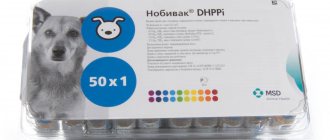Signs of pregnancy in dogs
Many owners ask what are the signs of pregnancy in a dog.
There are no signs of pregnancy in a dog in the early stages. At this time, it is impossible to determine whether the bitch will have puppies, either by palpation or by appearance.
The first signs of pregnancy in a dog after mating concern not physical condition, but behavior. The dog may become calmer, more affectionate, and sometimes show signs of illness.
Signs of pregnancy in a dog most often appear 21–22 days after mating. At this time, if you know where to look, you can feel small lumps on both sides of the abdomen. These lumps can be felt until the 35th day, and later become soft, so that they can be felt with difficulty. But by this time, signs of pregnancy include an enlarged belly.
By the 4th - 5th week, signs of pregnancy in a dog include thickening on the sides, the body becomes rounded. But sometimes these signs of pregnancy in a dog are visible only at the 7th week.
During the 5th week, enlarged nipples are added to the signs of pregnancy in the dog, and in the 6th week, if the bitch lies on her side, puppies can be felt in the horns of the uterus. A sign of pregnancy in a dog at the 7th week is a significant enlargement of the mammary glands. In the last week, a drooping belly is added to the signs of pregnancy.
One of the surest signs of pregnancy in a dog is the movement of the puppies.
Calendar by day
The process of bearing offspring in dogs takes only 2 months, but during this time new healthy, viable organisms have time to fully form before birth.
The embryonic development calendar by day looks like this:
- 1 day after mating – education. For better results, it is better to repeat the mating again after 2 days. However, even then fertilization may not occur if the egg is not yet ready. However, this does not mean that the bitch will not conceive. The sperm in the female’s body is able to live and perform its function for up to 7 days.
- 2 weeks - the embryos move into the uterus and attach there, the placenta is formed.
- Week 3 – active development of offspring organisms. At this time, physical signs of the situation begin to appear. It is very important to protect the animal from negative external influences and heavy physical activity.
- Day 29 – the appearance of the embryos is formed.
- Day 35 – vital systems are formed. At this time, you can do an ultrasound without fear of negative consequences.
- 57-60 days . The animal is actively engaged in arranging the future nest. Her anxiety is growing, she constantly needs a owner. The temperature drops by several degrees, which portends the imminent onset of labor.
How to detect pregnancy in dogs at home
You can determine if a dog is pregnant at home by the following symptoms:
- Changes in appetite (during mid-pregnancy, the dog usually loses his appetite).
- Vulvar discharge (4th week of dog's pregnancy).
- Decreased dog activity level.
- Enlargement of the dog's belly.
- Enlargement of dog's nipples.
How else can you tell if your dog is pregnant? There are additional ways:
- Pregnancy test. However, please note that a human pregnancy test will not help determine if a dog is pregnant.
- Veterinarian examination. Typically, if a dog is more than 25 days pregnant, the puppies' heartbeat can already be heard through a stethoscope.
- Ultrasound and X-ray.
- Analysis for relaxin is a hormone whose level in a dog’s blood during pregnancy is very high.
Dog pregnancy by days and weeks
The detailed course of a dog’s pregnancy by day and week can be traced using the following table.
| Day | The course of dog pregnancy by days and weeks |
| 1 | First mating. |
| 3 | Sperm enter the fallopian tubes. |
| 4 | Fertilization of eggs. The dog's behavior does not change, as do the conditions of detention. However, be careful not to overheat or dehydrate. |
| 5 – 11 days | Fertilized eggs are covered with the so-called. "three embryonic membranes". |
| 12 – 14 days | The embryos enter the uterus. At this point, the size of the embryos can reach 0.6 mm. |
| 15 days | The development of the puppy's organs begins. From this moment on, dog vaccination and treatment against parasites are prohibited. It is important to avoid changes in the dog’s daily routine and not expose it to stress. |
| 16 days | The bitch's nipples become slightly enlarged and turn pink, and the fur on her belly begins to thin out. |
| 21 day | Formation of the placenta. Pregnancy in a dog can be diagnosed - ultrasound makes it possible to notice the membranes. |
| 22 days | Hormonal changes in a dog can cause loss of appetite and nausea. Sometimes there is lethargy and bad mood. It is better to start feeding your dog more often, but reduce the portion size. |
| 25 days | The best time to perform an ultrasound. |
| 26 days | From this day on, introduce restrictions on the dog’s physical activity so that the embryos are not injured. |
| 30 days | The process of “calcification” of the jaws and skull continues, so calcium is introduced into the dog’s diet. |
| 32 days | The beginning of the second half of pregnancy. Embryos are already called fruits. Their weight at this moment is equal to 20% of the puppy's weight at birth. |
| 34 days | The bitch's behavior changes: she becomes more sensitive and quiet. The belly is enlarged. |
| 35 days | The bitch's appetite increases. It is necessary to increase the dog's daily diet by 10% and feed the expectant mother 3 times a day. However, do not overfeed your dog. |
| 44 days | Puppies can be felt by palpation. Increase your dog's diet by 15 - 20% compared to the usual rate. The number of feedings reaches 5 times a day. The dog's mammary glands become enlarged and hair may fall out around the nipples (but not necessarily). Do not allow the dog to make sudden movements, jump or run. |
| 48 days | The abdomen has noticeably increased in size. The dog behaves restlessly, looking for a secluded place for a nest. Begin to accustom the bitch to the place where the birth will take place. |
| 50 days | The puppies are noticeably moving. The size of the fetus is 75% of the weight of a newborn puppy. The volume of the dog’s diet is increased by 25–50% compared to usual. |
| 51 days | Sometimes drops of milk appear from the nipples, but not in all dogs. |
| 52 – 54 days | Remove calcium from your dog's diet. |
| 58 days | If you press on a bitch's nipple, milk appears. |
| 59 days | Start setting up a place for your dog to give birth. A dog can go into labor at any time. Take your bitch's temperature in the morning, afternoon and evening. If the temperature drops sharply, it means the dog will give birth within 24 hours. |
| 63 days | As a rule, 24 to 12 hours before giving birth, the dog refuses to eat, but some dogs eat heavily before giving birth. |
| 64 – 65 days | Approximate time of birth (date range: 57 to 69 days). Hormonal changes cause the uterus to contract and the puppies to appear. |
How is an ultrasound done?
Nothing scary or complicated: the veterinarian will put the dog on a diaper (which you should take with you, since the diapers provided are rarely stored in sealed packages), smear the area of study with a special gel and move the sensor over the skin. It’s not painful or scary, so don’t sympathize with the dog and don’t fuss - your pet will probably feel your tension and will also begin to worry, and tension and attempts to escape will make diagnosis difficult.
Regardless of whether they perform an ultrasound of the dog’s liver, bladder, or determine the number of puppies, the procedure lasts about 15 minutes. If it is much longer, you should suspect the doctor of unprofessionalism. Or, as an option, the device is very old and nothing can be seen on the monitor - in any case, this is a reason to go to another clinic.
If the fur on your pet's belly is thick and dense, it will probably have to be shaved off. This is necessary, since wool will prevent the sensor from sliding easily and making tight contact with the skin. It's a shame, but nothing terrible - the fur coat will grow back in a matter of weeks. If you don’t have a good machine at home, it’s better to entrust shaving your tummy to a veterinarian. But provided that the dog is accustomed to the machine and will not be overly nervous. If your pet is afraid of a haircut, you need to expose the belly in advance, a day before, so that the dog has time to calm down.
When an ultrasound is performed, the owner holds the dog himself and can look at the monitor together with the veterinarian. If the doctor is conscientious, he will definitely explain the picture and tell you what these or those shades, flickering, bulges, etc. mean.
After completing the procedure, the doctor will remove the gel with a napkin, explain the diagnosis and prescribe additional tests (when necessary). That's all - you can go home, not forgetting to praise the dog for the accomplished feat!
How to detect pregnancy in dogs at home
You can determine if a dog is pregnant at home by the following symptoms:
- Changes in appetite (during mid-pregnancy, the dog usually loses his appetite).
- Vulvar discharge (4th week of dog's pregnancy).
- Decreased dog activity level.
- Enlargement of the dog's belly.
- Enlargement of dog's nipples.
How else can you tell if your dog is pregnant? There are additional ways:
- Pregnancy test. However, please note that a human pregnancy test will not help determine if a dog is pregnant.
- Veterinarian examination. Typically, if a dog is more than 25 days pregnant, the puppies' heartbeat can already be heard through a stethoscope.
- Ultrasound and X-ray.
- Analysis for relaxin is a hormone whose level in a dog’s blood during pregnancy is very high.
Ultrasound of a dog during pregnancy
An ultrasound of a dog during pregnancy is often performed. Ultrasound is the optimal method for diagnosing pregnancy in a dog.
An ultrasound of a dog during pregnancy can be performed from the 15th day after mating, but the optimal time for an ultrasound of a dog during pregnancy is 24–28 days. It is at this time that the heartbeat of future puppies can be detected.
An ultrasound of a dog during pregnancy makes it possible to assess the condition of the fetuses by observing their movements, heartbeat, etc. You can determine the size of the puppies and their approximate age. And on day 28, an ultrasound is 99.3% accurate in determining whether a dog is pregnant.
But it is difficult to accurately determine the number of future puppies using ultrasound.
Advantages of dog ultrasound
The ultrasound diagnostic method has many advantages over other methods:
- painlessness and safety;
- no invasive intervention;
- information content;
- the opportunity to see the condition of internal organs;
- accessibility (the device is available in most veterinary clinics;
- low cost of the procedure (unlike MRI and CT);
- the ability to examine organs in real time and track dynamics;
- instant results;
- The procedure does not last long.
In some cases, the dog may require additional diagnostics using other methods. This is decided by the veterinarian.
Ultrasound is a painless method that gives quick results
We must always remember that ultrasound cannot be the only diagnostic method. To make the correct diagnosis, a comprehensive diagnosis is carried out: in addition to ultrasound, the dog needs to have an X-ray, ECG, EchoCG, gastroscopy, MRI, laboratory tests of blood, urine, feces, swabs, etc.
Discharge in a dog during pregnancy
After mating, the dog's estrus should stop, but there are cases when a dog discharges during pregnancy.
If your dog's discharge during pregnancy is not too heavy, light pink or clear, this is normal.
Also, on the 21st day of pregnancy, after urinating, dogs have clear, watery discharge - this is also normal. A clump of mucus may hang on a loop or stick together in the dog's fur under the tail. If the bitch is not washed, the discharge may form a brown or caramel crust. Sometimes black or greenish clots come out with mucus - these are embryos that died at the beginning of development.
If a dog’s discharge during pregnancy (3rd – 4th week) is bloody and bright red, this is a reason to immediately contact a veterinarian. There may be several reasons for such discharge, but it is necessary to do an ultrasound to rule out uterine rupture.
If a dog's discharge during pregnancy (at any stage) is dark green, with a strong putrid odor, this may indicate the death of the fetus or placental abruption. Don't wait - take your bitch to the vet as quickly as possible. Otherwise, you risk losing not only all the puppies, but also the dog!
1 - 2 days before giving birth, the dog begins to have discharge of a light brown, greenish or whitish hue - this is also normal and signals the approach of labor
Termination of pregnancy in dogs
Sometimes an unplanned mating occurs, and the owner turns to the veterinarian with the question of whether it is possible to terminate the dog’s pregnancy.
So, is it possible to terminate a dog’s pregnancy and how to terminate a dog’s pregnancy?
Termination of pregnancy in a dog in the early stages is possible through the use of hormonal drugs that prevent the implantation of fertilized eggs into the walls of the uterus. Such termination of pregnancy in a dog occurs within 7 days after using the drug.
After your dog has had an abortion, you must return to your veterinarian to confirm the abortion using an ultrasound.
Another option for terminating a dog’s pregnancy is surgery, which involves removing the uterus and fetuses.
False pregnancy in a dog
Many owners confuse a false pregnancy with a failed one. What is a false pregnancy in a dog? False pregnancy is a physiological condition of a dog that, without being mated, exhibits all the symptoms of pregnancy.
Symptoms of a false pregnancy in dogs resemble those of a real pregnancy. The dog prepares the nest, experiences something reminiscent of labor pains, and may handle toys as if they were puppies.
Many owners are wondering: if a dog has a false pregnancy, what to do? First of all, you should contact a veterinarian - you may have to give the dog sedatives that will help the animal return to normal.
Sometimes a false pregnancy in a dog indicates the presence of an inflammatory process in the uterus, and this requires serious treatment.
Sometimes it happens that about a month after mating the bitch, the puppies “dissolve”, although the signs of pregnancy in the dog do not disappear. This phenomenon is called a “failed” pregnancy, and should not be confused with a false pregnancy. False pregnancy in a dog is a condition when signs of pregnancy and childbirth appear in a dog that has not been bred.
How to prepare a dog?
Preparing for an abdominal ultrasound in dogs does not require any special skills or effort from the owner. The main thing is to stop giving your pet all foods that can cause constipation or flatulence within 24 hours. Cartilage, muscles and other nibbles, milk and sour milk, rice porridge, cabbage, beans, bread and baked goods, pasta, and fatty foods are removed from the diet.
If the dog chronically suffers from constipation, you need to do an enema or (which is easier) give your pet a mild laxative after consulting a veterinarian. If your pet has a tendency to flatulence, you need to give him activated charcoal (1 tablet/10 kg) or enterosgel (a teaspoon for a baby, a tablespoon for a large dog) the day before, repeat 6 hours before the procedure.
12 hours before - only a light snack, 6-8 hours before the pet stops feeding and is given a good walk so that the dog has a bowel movement. Don't worry - a short fast will only benefit you. If the dog is terrified of veterinarians, you can give a light sedative approved by the doctor in advance. Sometimes before an ultrasound it is necessary to fill the bladder (force water or give a diuretic). If your dog is aggressive, be sure to take a muzzle with you. All recommendations are general. Please be sure to ask your attending veterinarian about preparations.











